The seven-page article presented what was known about the three generations of men named Hans Jacob Brubacher who lived in what was then Martic Township (now Providence Township) in Lancaster County, Pennsylvania from about 1730 through 1817. Information from Mr. Johnson's research in land and estate records combined with that from Phares Brubaker Gibble's "History and Genealogy of the Brubaker, Brubacher, Brewbaker family in America" provides a good summary of the family, though with at least one error, which may be the subject of a future post.
Hans Jacob Brubaker III is my 5th great-grandfather. His father, Hans Jacob II - the Fraktur Artist, is my 6th great-grandfather. His father, Hans Jacob I, is my 7th great-grandfather.
In his will (dated June 24, 1754 and recorded in Lancaster County Will Book 1 pages 89-90) Hans Jacob Brubacher identified himself as a weaver. Proved on April 17, 1755 the will stated that he owned real estate but did not provide a location or description of the land.
On page 11, the author of the Fraktur Artist article cites several passages from "History of Lancaster County, Pennsylvania, with Biographical Sketches of Many of Its Pioneers and Prominent Men", by Franklin Ellis and Samuel Evans (Philadelphia: Evens & Peck, 1883), p. 868:
The elder Hans Jacob acquired 124 acres of land through agents John Herr and Martin Kendig in 1730, "about one mile due southwest from the present village of New Providence, near Big Beaver Creek."
The author continues by saying (emphasis added):
A more garbled account by the same authors gives similar information in a history of the town of New Providence: "A man by the name of Powpather had a large tract of land close by, if not altogether in the limits of the present village. His land extended westward. When he divided his land among his children he changed the name on their deeds to 'Brubaker.'"
Mr. Johnson goes on to say:
The location of the first Jacob Brubacher's land is still uncertain. The most probable tract is the one consisting of 318-plus acres, for which Henry Herr obtained warrant, survey, and patent in 1762 and which was located one mile or more south-southwest of the village of New Providence.
In the footnote for the above statement, citing Patent AA-3-296 and Survey C-76-209, the author states: "As yet no patent, survey, or deed for the elder Jacob Brubacher has surfaced."
Referring to the will and the estate of the elder Hans Jacob, Mr. Johnson states:
"The deceased owned about 150 acres in what was then Martic Township. Because his personal estate was insufficient to pay all expenses, a sale of 60 acres of his land was contemplated, but the family later agreed to sell the whole tract. Jacob Graeff was the highest bidder of £114 at the sale which took place on April 27, 1757, but the court refused to confirm the sale when Thomas Smith, a local resident, appeared and claimed that others present at the bidding did not have time to submit their bids. On December 31, 1757, another sale was held on the premises. This time Henry Herr purchased the farm for £130 5s. and agreed to take responsibility for the widow's bequeathments. When the estate was settled, a final balance was equally divided among the four inheriting children, each of whom received £17 10s. 9d. Henry Herr may have been a close friend or relative; the year before the sale, minor child Abraham Brubacher chose him as guardian."
While looking for county and state resources available online for Pennsylvania in preparation for on-site research in the areas where several ancestors lived, I "discovered" the awesome website of the Pennsylvania Historical and Museum Commission, particularly the Land Records Portal associated with the State Archives.
Available online through the above mentioned Land Records Portal are digital images of land warrants, surveys, patents, warrantee township maps, and other associated state-level land records from the 1680s to the present day. They DO NOT have the deed books for transactions "transferring land between private citizens that occurred either after or during the patenting process." Those records are maintained at the office of the Recorder of Deeds for the appropriate county.
Some image sets, such as the warrantee township maps, do not include coverage for all counties or even all townships within a county. It does get a little confusing, since there were so many county boundary changes, and it takes time to figure out what you're looking for and then even determining what you are looking at. But it is well worth the time it takes.
Sometimes a warrant was issued but the patent wasn't filed until many years later. Such was the case of the land of Hans Jacob Brubacher II. One warrant for his land was dated July 20, 1748 and another on March 9, 1759 but the patents were not issued until February 23, 1813.
I first looked at the Warrantee Township Maps. There are very few available for the counties where my ancestors settled, but there just happened to be one for Providence Township, Lancaster County. These maps show all original land purchases from the Proprietors or the Commonwealth that were made within the boundaries of present-day townships. The warrants and surveys will generally be found in the county at the time they were issued. Like I said, it does get a bit confusing!

The maps are large pdf files. This one was 7.5mb and I imagine the original was several feet wide. You have to enlarge the map considerably to be able to read the text. Then you look through the names on the map to find your person(s) of interest. The numbers in the upper left of each entry indicate the location on the map. I was looking for Jacob Brubaker but was pleasantly surprised to find the name of Thomas Stoneroad also.
According to the Phares Gibble book (page 76) Jacob Brubaker III married Elizabeth Stoneroad. Records show that the surname was originally Steinweg or Steinweeg. The surnames seem to have been used interchangeably for a period of time in the 1780s through the early 1800s. Apparently "stein" is a German and Norwegian word meaning "stone" or "rock" and "weg" means way or road. Thus Stoneroad is the anglicized equivalent of Steinweg.

Above is a very small portion of the Warrantee Township Map for Providence Township (double-click the image to view a larger version). The area outlined in blue is the location of the land of Jacob Brubaker II, which was inherited by Jacob III. The area outlined in green is the tract of Thomas Stoneroad.
Below is survey C-16-89 for Jacob Brubaker (II). The text reads:
A Drought of a Tract of Land Situate in Martick Township in the County of Lancaster Containing in the whole 107 as & 166 pr & the usual allowance of Six P Cent for the Roads &c 72 as & 76 pr & the usual Allowance Surveyed in pursuance of a warrant dated the 8th of March AD 1759* Granted unto Jacob Brubacker and 35 as & 90 pr and the usual Allowance, being part of a Larger Tract Containing -
Surveyed in pursuance of a Warrant dated the 8th of March AD 1759 Granted unto Thomas Smith &c Surveyed the above tract of Land for Abraham Brubaker the 11th day of January AD 1810.
Jacob Hibshman D.S.
* Brubacker's Warrt is Dated 20 July 1748

Survey C-16-89 for Jacob Brubaker.
I also looked up the survey for Thomas Stoneroad. The surname is unique enough that I've been gathering whatever information I can find on anyone with that surname.

Survey C-201-16 for Thomas Stoneroad.
His tract of land is 42 acres. But what I found very interesting is that his name is associated with the tract labeled A-51-104, which is the survey number. So, yeah, I grabbed that one too.

The original survey A-51-104 is for Jacob Prowpather!
Yes! This is the record that had previously not been found! And I wouldn't have found it either if I hadn't looked at the survey for Thomas Stoneroad. Luckily, my friend Cindy was at home with me at the time and I was able to share this discovery with her, though I'm sure I didn't explain it all very well. It was just nice to be able to talk it over with someone else who "understands" these things!
The document text reads:
Jacob Prowpather 124 acres & the allowance of Six pcent situate on a Branch of Beaver Creek in the County of Lancaster Surveyd to him in right of Martin Kendrick & John Heer [sic: Herr], the 4th of November 1730.
Jno. Taylor.
Warrt. 22 November 1717.
Returned &ca. Novr. 29th 1764 for the use of Martin Funk in pursuance of a Warrt. dated the 26th day of Novr. 1764 now Situate in Martick Township in the County of Lancaster.
No Warrant or Patent was found for this land in Lancaster County or Chester County in the name of Jacob Prowpather or Jacob Brubaker or other variations of the surname. (Lancaster County was a part of Chester County until 1729.) I didn't really expect to find either record since the tract was "in right of" Kendrick and Heer.
Records at the county level will have to be checked to find the deeds for when Jacob sold the land and for Thomas Stoneroad's purchase of the land.

Looking at the Warrantee map once again, we see that the land identified as survey A-51-104 (outlined in red) belonged to Martin Funk and is the same property originally owned by Jacob Prowpather, aka Jacob Brubaker (the 1st) from 1730 until his death in 1755. The land that Thomas Stoneroad obtained in 1804 is outlined in green, and that of Jacob II (and III), which they owned from 1748 to about 1817, is outlined in blue.
In his article, David R. Johnson included two diagrams of the property of Jacob II, one of which placed the property in a present-day (1986) map. Using his drawings and Google Maps, I was able to locate the Brubaker tracts on a road map and on a satellite view.


That dark line running from the left-center and curving down the lower-right of the image is the Enola Low Grade Trail, which opened last year. I may just have to check that out (amongst other things) on my way through Pennsylvania this coming week!
I haven't gotten through the entire list of Pennsylvania ancestors yet, but I have found warrants, surveys, and patents for the lands of 12 of them! All in all, the last couple of days have been very productive...






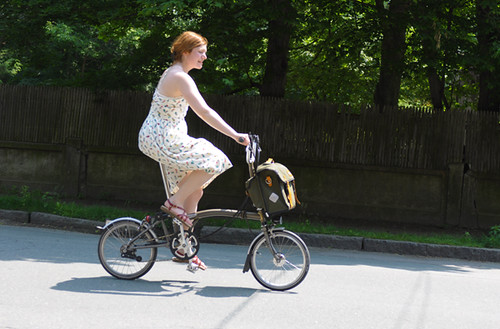
 You are Master. I am dog. Lie down....no problem!
You are Master. I am dog. Lie down....no problem! I'll just stay here. With you. Until you let me know when I can get up. Or until.....
I'll just stay here. With you. Until you let me know when I can get up. Or until..... something else distracts me and I forget all about you....
something else distracts me and I forget all about you.... Living the life in Florida with our adorable free range Merle-like dog!
Living the life in Florida with our adorable free range Merle-like dog!
 Yesterday was one of the warmest days of September, and we decided to give swimming a try. I've mentioned that there have beenshark sightings on the Cape over Labor Day Weekend. That was more than two weeks ago, but still we chose a beach that was not one of the beaches where the shark sightings were reported. We went to the large and popular Marconi Beach, a beautiful ride from the place we are staying. Well, it looks like we have sightings of our own to report.
Yesterday was one of the warmest days of September, and we decided to give swimming a try. I've mentioned that there have beenshark sightings on the Cape over Labor Day Weekend. That was more than two weeks ago, but still we chose a beach that was not one of the beaches where the shark sightings were reported. We went to the large and popular Marconi Beach, a beautiful ride from the place we are staying. Well, it looks like we have sightings of our own to report. Here is a lovely seal, whom we saw once again very close to the shore (different beach than last time). This time I captured him on camera. There were surfers and swimmers in the water very close to the seal, reaching out to him and cooing.
Here is a lovely seal, whom we saw once again very close to the shore (different beach than last time). This time I captured him on camera. There were surfers and swimmers in the water very close to the seal, reaching out to him and cooing. Definitely
Definitely 



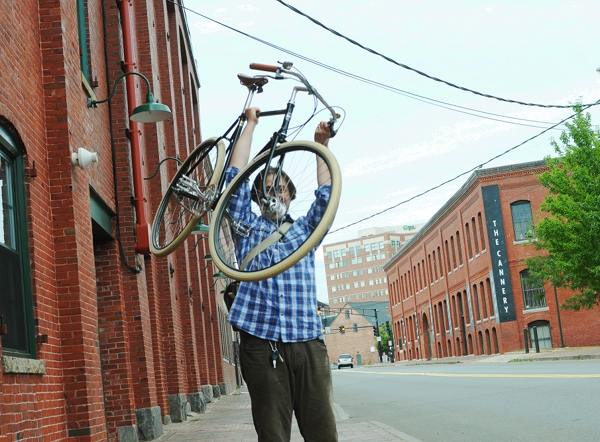 When borrowing bikes from Portland Velocipede, I had thought the Co-Habitant might like to try something entirely new, like a Gazelle or a Brompton. But he is a die-hard Pashley fan and seized the opportunity to ride the Pashley Guv'nor.The man is not overly fond of writing, so I will do my best to communicate his impressions - though the picture above pretty much says it all.
When borrowing bikes from Portland Velocipede, I had thought the Co-Habitant might like to try something entirely new, like a Gazelle or a Brompton. But he is a die-hard Pashley fan and seized the opportunity to ride the Pashley Guv'nor.The man is not overly fond of writing, so I will do my best to communicate his impressions - though the picture above pretty much says it all.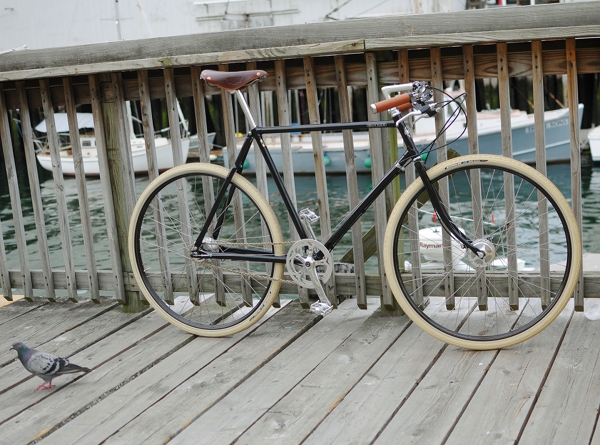 The Pashley Guv'nor is modeled on the 1930s Path Racer, and its faithfulness to this concept is remarkable. The frame is relaxed, with the same frame geometry and 28" wheel size as the Pashley Roadster. But while the Roadster is made of high-tensile steel (heavy, utilitarian), the Guv'nor is made of Reynold's 531 tubing (super light, high-end).
The Pashley Guv'nor is modeled on the 1930s Path Racer, and its faithfulness to this concept is remarkable. The frame is relaxed, with the same frame geometry and 28" wheel size as the Pashley Roadster. But while the Roadster is made of high-tensile steel (heavy, utilitarian), the Guv'nor is made of Reynold's 531 tubing (super light, high-end). Additionally, the Guv'nor features fancier lugwork, and is equipped with sportier and more luxurious components - such as the racy upside down "North Rroad" handlebars, a Nitto stem, leather grips, and a Brooks B17 Titanium saddle. It is available as a single speed or a 3-speed, and a crazy limited edition with 4 speeds and golden lugs exists as well.
Additionally, the Guv'nor features fancier lugwork, and is equipped with sportier and more luxurious components - such as the racy upside down "North Rroad" handlebars, a Nitto stem, leather grips, and a Brooks B17 Titanium saddle. It is available as a single speed or a 3-speed, and a crazy limited edition with 4 speeds and golden lugs exists as well.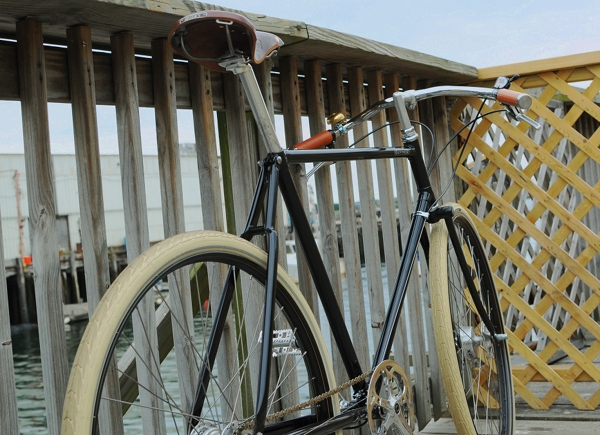 The Guv'nor is fitted with cream Schwalbe Delta Cruiser tires, and it intentionally lacks fenders. No lights or racks either. Like a traditional path racer, this bicycle has a high bottom bracket and horizontal chain stays. Because of the high bottom bracket and theslack seat tube, there is a huge amount of seat post showing, which exaggerates the aggressive appearance. Although the Co-Habitant's Roadster has the same amount of exposed seat tube, this is disguised by the huge rails and springs of the Brooks B-33 saddle that the Roadster is fitted with. The flat and unsprung B17 on the Guv'nor, on the other hand, leavesevery millimeter exposed.
The Guv'nor is fitted with cream Schwalbe Delta Cruiser tires, and it intentionally lacks fenders. No lights or racks either. Like a traditional path racer, this bicycle has a high bottom bracket and horizontal chain stays. Because of the high bottom bracket and theslack seat tube, there is a huge amount of seat post showing, which exaggerates the aggressive appearance. Although the Co-Habitant's Roadster has the same amount of exposed seat tube, this is disguised by the huge rails and springs of the Brooks B-33 saddle that the Roadster is fitted with. The flat and unsprung B17 on the Guv'nor, on the other hand, leavesevery millimeter exposed. Front and rear drum brakes give the bicycle a clean appaerance.
Front and rear drum brakes give the bicycle a clean appaerance. They also allow for black rims with golden pinstriping (not really captured in the pictures, but it's there).
They also allow for black rims with golden pinstriping (not really captured in the pictures, but it's there). Drivetrain and track fork ends. The one aspect of the Guv'nor's components the Co-Habitamt dislikes are the cranks; he thinks they are "ugly" - though personally, I do not think they are bad looking.
Drivetrain and track fork ends. The one aspect of the Guv'nor's components the Co-Habitamt dislikes are the cranks; he thinks they are "ugly" - though personally, I do not think they are bad looking. Close-up of the handlebars, with brass bell and retro-style Sturmey Archer 3-speed shifter.
Close-up of the handlebars, with brass bell and retro-style Sturmey Archer 3-speed shifter.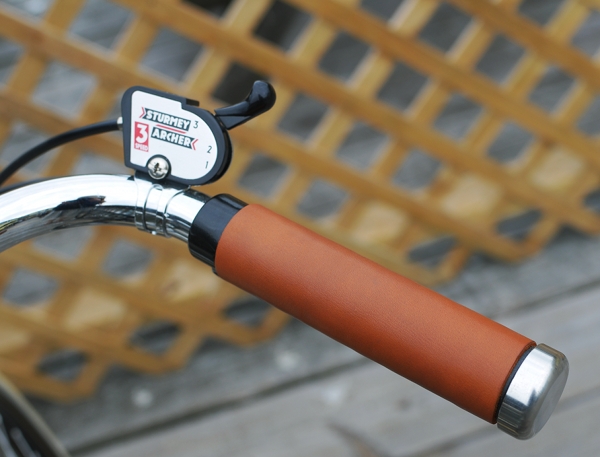 The vintage-looking shifter is a nice touch.
The vintage-looking shifter is a nice touch.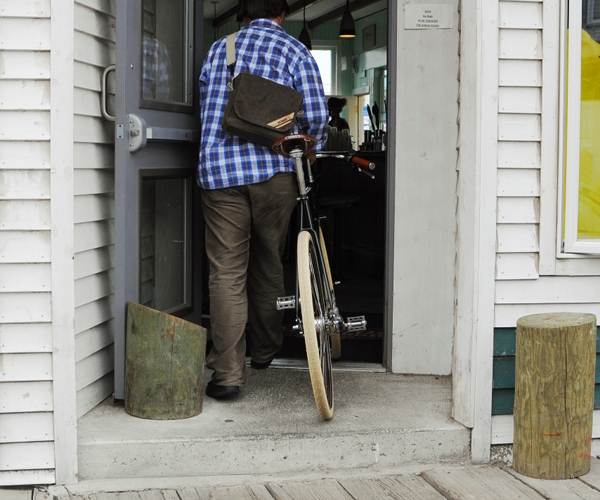 As I didon the Abici, the Co-Habitant rode around Portland, Maine on the Guv'nor - even taking it along into a dining establishment. No one seemed to mind and the bicycle received compliments.
As I didon the Abici, the Co-Habitant rode around Portland, Maine on the Guv'nor - even taking it along into a dining establishment. No one seemed to mind and the bicycle received compliments. The Pashley Guv'nor, waiting for hisbeer and calamari.Unlike the Pashley Roadtser, it is extremely easy to maneuver and drag around due to its light weight.
The Pashley Guv'nor, waiting for hisbeer and calamari.Unlike the Pashley Roadtser, it is extremely easy to maneuver and drag around due to its light weight. In terms of ride quality, the Guv'nor handles like a cross between a roadster and a road bike. It is very light, fast, and maneuverable - yet also stately. Some aspects of the geometry can take getting used to: Because the saddle is so far back due to the slack seat tube (plus the seat post has set-back), the handlebars are extremely far away. The Co-Habitant thinks that Pashley should have either used a shorter stem, or a seat post with no set-back; otherwise the posture feels too extreme - especially in combination with the slack seat tube and the forward position of the pedals.
In terms of ride quality, the Guv'nor handles like a cross between a roadster and a road bike. It is very light, fast, and maneuverable - yet also stately. Some aspects of the geometry can take getting used to: Because the saddle is so far back due to the slack seat tube (plus the seat post has set-back), the handlebars are extremely far away. The Co-Habitant thinks that Pashley should have either used a shorter stem, or a seat post with no set-back; otherwise the posture feels too extreme - especially in combination with the slack seat tube and the forward position of the pedals. Riding the bike around town was tremendous fun for the Co-Habitant, and of course he would love to own such a bike in a world unhindered by practical considerations. But the Guv'nor woud hardly be a reasonable choice for regular commuting, given its lack of fenders and lights. And while in theory, these could be installed, doing so would ruin the authentic Path Racer look - which is the very heart of the concept behind the Guv'nor. Ultimately, theGuv'norwas not designed for practicality and makes no claims to be a daily commuter. It is a trophy-bike, meantto be taken out in fair weather and enjoyed for its unique ride quality and vintage aesthetics. More than anything, it is the concept itself that is impressive: Pashleycreated this bicycle true to the original and made it painfully handsome in the process.
Riding the bike around town was tremendous fun for the Co-Habitant, and of course he would love to own such a bike in a world unhindered by practical considerations. But the Guv'nor woud hardly be a reasonable choice for regular commuting, given its lack of fenders and lights. And while in theory, these could be installed, doing so would ruin the authentic Path Racer look - which is the very heart of the concept behind the Guv'nor. Ultimately, theGuv'norwas not designed for practicality and makes no claims to be a daily commuter. It is a trophy-bike, meantto be taken out in fair weather and enjoyed for its unique ride quality and vintage aesthetics. More than anything, it is the concept itself that is impressive: Pashleycreated this bicycle true to the original and made it painfully handsome in the process.





 Scott-Keister Cemetery, Etna-Troy Township, Whitley County, Indiana
Scott-Keister Cemetery, Etna-Troy Township, Whitley County, Indiana photo by Robert Boeschhttp://www.robertboesch.ch/
photo by Robert Boeschhttp://www.robertboesch.ch/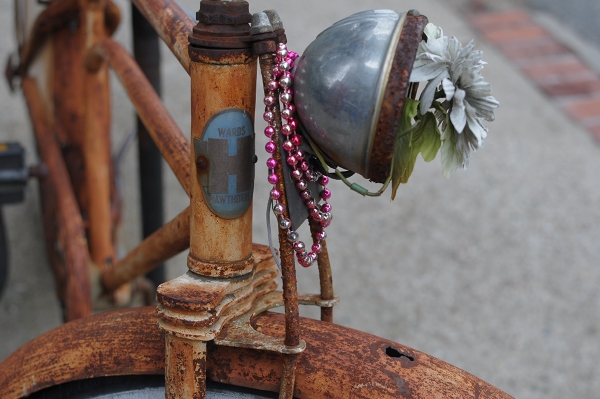 When getting a bicycle, whether new or vintage, it can be nice to personalise it - to make alterations here and there, so that the bike feels distinctly "ours". I am often asked for advice regarding various aspects of this process, from budget, to component choices, to colour coordination. And while these things are highly personal, there are several general points that I propose keeping in mind.
When getting a bicycle, whether new or vintage, it can be nice to personalise it - to make alterations here and there, so that the bike feels distinctly "ours". I am often asked for advice regarding various aspects of this process, from budget, to component choices, to colour coordination. And while these things are highly personal, there are several general points that I propose keeping in mind.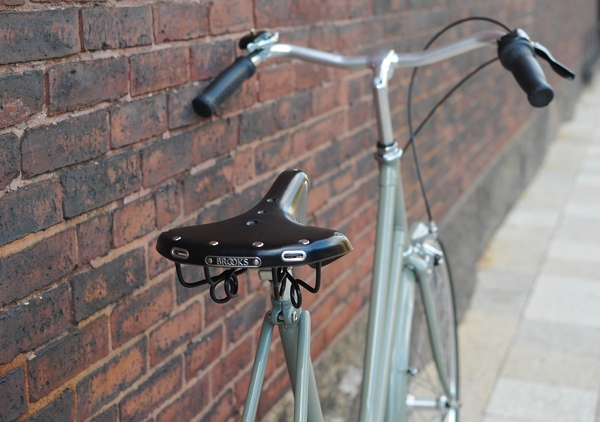 1. Address functionality and comfort before looks. Prior to buying colourful panniers and covering the bike with flower garlands, make sure the saddle position and handlebar height are properly adjusted for your proportions and postural preference. You may be surprised how much just that factor alone can change the "personality" of the bicycle. And this, in turn, will better inform subsequent aesthetic choices.
1. Address functionality and comfort before looks. Prior to buying colourful panniers and covering the bike with flower garlands, make sure the saddle position and handlebar height are properly adjusted for your proportions and postural preference. You may be surprised how much just that factor alone can change the "personality" of the bicycle. And this, in turn, will better inform subsequent aesthetic choices.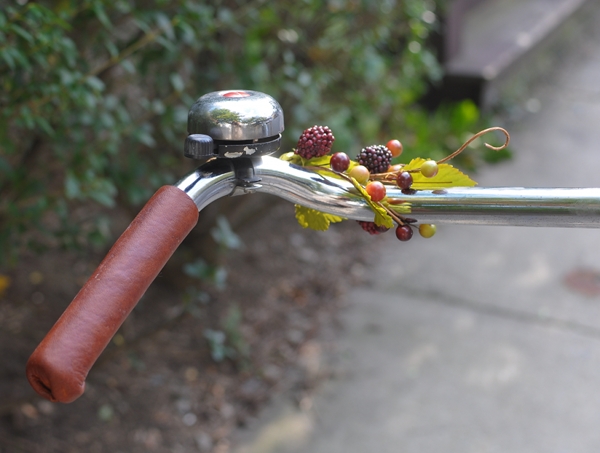 2. Personalising the looks of your bicycle need not involve buying lots of costly accessories. Some of the most delightful decorations are also the least expensive. Consider that things like ribbon,faux florals,twine, and stickers can cost mere pocket change. A simple bow in your favourite colour on the handlebars, or some flowers along the edge of your basket, will create an instant, lively transformation. And if you have an old bicycle with scratched up paint? You could turn it into a "zebra bike", "tiger bike", or "bumble bee bike" by wrapping appropriately coloured electrical tape around the frame to create stripes.
2. Personalising the looks of your bicycle need not involve buying lots of costly accessories. Some of the most delightful decorations are also the least expensive. Consider that things like ribbon,faux florals,twine, and stickers can cost mere pocket change. A simple bow in your favourite colour on the handlebars, or some flowers along the edge of your basket, will create an instant, lively transformation. And if you have an old bicycle with scratched up paint? You could turn it into a "zebra bike", "tiger bike", or "bumble bee bike" by wrapping appropriately coloured electrical tape around the frame to create stripes. Of course, with an older bicycle there is also the option of using paint. You could trylug outlining, hand-painting small panels, or even paintingyour own designs along the entire frame. In Europe I see bicycles hand-painted with flowers, polka-dots, zebra stripes, peace symbols, lady bugs, and all sorts of other simple motifs.A paint pen for lug outlining will set you back around $2. Enamel paint will cost around $6 for a small can.
Of course, with an older bicycle there is also the option of using paint. You could trylug outlining, hand-painting small panels, or even paintingyour own designs along the entire frame. In Europe I see bicycles hand-painted with flowers, polka-dots, zebra stripes, peace symbols, lady bugs, and all sorts of other simple motifs.A paint pen for lug outlining will set you back around $2. Enamel paint will cost around $6 for a small can. 3. Avoid formulaic accessorising. If you saw it in a magazine or on a popular blog, chances are that so did hundreds of others. Do you really want to spend all that money on limited edition saddles, deluxe grips and exotic tires, just to end up with a bicycle that looks identical to lots of other bikes? Take the time to consider what combination of things would suit you individually, rather than trying to recreate a popular look.
3. Avoid formulaic accessorising. If you saw it in a magazine or on a popular blog, chances are that so did hundreds of others. Do you really want to spend all that money on limited edition saddles, deluxe grips and exotic tires, just to end up with a bicycle that looks identical to lots of other bikes? Take the time to consider what combination of things would suit you individually, rather than trying to recreate a popular look.
 In the end, the bicycles that are the most striking and feel the most "yours" are those that reflect your personality - regardless of the budget that went into achieving that.
In the end, the bicycles that are the most striking and feel the most "yours" are those that reflect your personality - regardless of the budget that went into achieving that.